Braunschweig
![]()
This article is about the German metropolis. For other meanings, see Braunschweig (disambiguation).
Braunschweig (Low German Brunswiek, Ostfälisches or Braunschweiger Platt: Bronswiek) is a large city in the southeast of the state of Lower Saxony. With 248,561 inhabitants (as of 31 December 2020), it is the second largest city in Lower Saxony after Hanover. The independent city is part of the metropolitan region Hannover-Braunschweig-Göttingen-Wolfsburg, founded in 2005. Around 337,000 people live in the Braunschweig conurbation (agglomeration).
Braunschweig's origins date back to the early 9th century. Especially through Henry the Lion, the city quickly developed into a powerful and influential trading metropolis, which belonged to the Hanseatic League from the middle of the 13th century. Braunschweig was the capital of the state of the same name until it was absorbed into the newly created state of Lower Saxony in 1946. Braunschweig was the seat of an administrative district until 1978, and of a governmental district between 1978 and 2004. This was then replaced by a government district and in 2014 by the current regional commissioners for south-eastern Lower Saxony.
Today, the Braunschweig region is a significant European location for science and research: In 2015, 9.5 percent of the gross domestic product was invested in research. Within the European Union, Braunschweig has been the most intensive region in terms of research and development since 2007. In 2010, for example, the 15 leading EU regions in terms of expenditure on research and development as a proportion of gross domestic product (GDP) were already above the target of three per cent set by the Lisbon Strategy; only three of these 15 regions exceeded five per cent, led by Braunschweig with 5.83 per cent, followed by West Sweden with 5.40 per cent and Stuttgart with 5.37 per cent. The Donors' Association for the Promotion of Sciences and Humanities in Germany awarded Braunschweig the title "City of Science" for 2007.
.JPG)
Aerial photo from April 2007 with view in northeast direction: It shows among other things the wooded Okerring.
.JPG)
City centre 2011: You can see Petritorbrücke with crossing Radeklint (bottom middle), Petrikirche (right of Radeklint), Brüderkirche, Andreaskirche, Katharinenkirche, castle, cathedral, city hall, Magnikirche, Staatstheater (left, middle of the picture), Herzog Anton Ulrich-Museum, Aegidienkirche, Braunschweig main station (top right in the background).

The Braunschweig Lion, symbol of the city since the High Middle Ages. It stands on the Burgplatz.
Geography
Geographical location
Braunschweig is located in the North German Lowlands on the dividing line between the Loess Uplands of the Northern Harz Foreland and the Geest Plains beginning in the northern part of the city. In detail, four natural areas meet in the area of the core city: the southeastern East Braunschweig Hills, the Braunschweig-Hildesheim Loess Plateau extending to the southwest, the northwestern Burgdorf-Peiner Geestplatten and the northeastern East Braunschweig Plain spreading towards Wolfsburg. The Oker river, running in a south-north direction, forms a natural boundary with the Börßum-Braunschweig Oker valley and the partly fragile, formerly marshy soils.
The river is dammed in the south by a weir and flows around the town centre to the west and east in two bypass ditches, which were created for better defence in the Middle Ages and reunite in the northwest of the town. Two further weirs regulate the water level in the town area. Other watercourses are the Wabe and the Mittelriede, which flow into the Schunter in Braunschweig.
The urban area covers an area of 192 km², enclosed by a city boundary with a length of 98 km. The north-south extension is 19.1 km and the west-east extension is 15.7 km. The inner city area is located at an average altitude of 70 m above sea level. The highest elevation is the Geitelder Berg with a height of 111 m above sea level; the lowest point is an old Oker loop with 62 m above sea level in the northwest.
Clockwise, starting in the northeast, the following municipalities border on Braunschweig: Lehre (district of Helmstedt), Cremlingen, Sickte (joint municipality of Sickte) and Wolfenbüttel (all district of Wolfenbüttel), Salzgitter (independent city), Vechelde and Wendeburg (district of Peine) as well as Schwülper, Vordorf and Meine (all joint municipality of Papenteich, district of Gifhorn).
| Bremen (170 km) | Lüneburg (110 km) | Salzwedel (95 km) |
| Minden (140 km) |
| Magdeburg (100 km) |
| Hildesheim (45 km) | Wolfenbüttel (10 km) | Bernburg (Saale) (115 km) |
* Distances are rounded road kilometres to the town centre.
City breakdown
The urban area was divided into 22 municipal districts from November 1981 in accordance with the Lower Saxony Municipal Code (NGO) in force at the time. Their number was reduced after ten years to 21 (by merging Lehndorf-Lamme-Kanzlerfeld and Watenbüttel-Ölper-Völkenrode into Lehndorf-Watenbüttel), after another ten years to 20 (by merging Südstadt-Rautheim and Mascherode into Südstadt-Rautheim-Mascherode) and again after ten years to 19 (by merging Wabe-Schunter and Bienrode-Waggum-Bevenrode into Wabe-Schunter-Beberbach). As a result of a reorganization of the Lower Saxony state parliamentary constituencies, from whose constituency number the first digit of the borough number is derived, there was also a change in the official borough numbers. The current 19 city districts are:
- 112: Wabe-Schunter-Beberbach
- 113: Hondelage
- 114: Volkmarode
- 120: Eastern ring area
- 131: City centre
- 132: Viewegsgarten-Bebelhof
- 211: Stöckheim-Leiferde
- 212: Heidberg-Melverode
- 213: Südstadt-Rautheim-Mascherode
- 221: West city
- 222: Timmerlah-Geitelde-Stiddien
- 223: Broitzem
- 224: Rüningen
- 310: West ring area
- 321: Lehndorf-Watenbüttel
- 322: Veltenhof-Rühme
- 323: Wenden-Thune-Harxbüttel
- 331: North city
- 332: Schunteraue
A city district council is elected for each city district - with a number of, depending on the number of inhabitants, at least 7 and at most 19 members, as specified in the city's main statutes, who have each elected a district mayor and his deputy from among their number as chairmen. In addition to the general representation of the interests of their respective district and the promotion of its positive development within the city of Braunschweig as a whole, the area of responsibility of the city district councils includes decisions on the matters of their own sphere of action assigned to them by the Lower Saxony Municipal Constitution Act (NKomVG) (which replaces the NGO) and the main statutes, and on citizen surveys in the city district. In addition, the municipal district councils have the right to be heard on urban land-use planning as well as on other matters of their own and transferred sphere of action prior to resolutions of the council and the administrative committee, to demand residents' meetings to be held by the chief administrative officer, to submit proposals, to make suggestions and to express concerns.
For voting in political elections, the city is divided into 169 general voting districts and 36 postal voting districts. For municipal elections, the electoral area for the election of municipal district councillors consists of the area of the respective municipal district, and for the election of the representation (city council) and the direct election of the chief administrative officer (mayor) consists of the entire city area, which is thereby divided into eight electoral areas. The municipal electoral areas are:
|
|
|
In state parliament elections in Lower Saxony, the city area is divided into the three state parliament constituencies Braunschweig-Nord, Braunschweig-Süd and Braunschweig-West, with the special feature that the constituency Braunschweig-Süd includes the municipality of Vechelde, which lies in the district of Peine. In federal elections, the constituency of Braunschweig is congruent with the urban area, which is also not further subdivided in European elections - in each case except for the division into electoral districts for voting.
For statistical purposes, the urban area of Braunschweig is divided into a total of 74 statistical districts, which are numbered consecutively and mostly bear historical names.
- 01 Town centre (old town, castle and sack)
- 02 Hagen
- 03 Altewiek
- 04 Hoor
- 05 New town
- 06 Old university quarter
- 07 At the Hagenring
- 08 Prinzenpark
- 09 Vieweg's garden
- 10 Citizens' park
- 11 Wilhelmitor South
- 12 Wilhelmitor North
- 13 Petritor East
- 14 Petritor-West
- 15 Petritor North
- 16 North station
- 17 New university quarter
- 18 Gliesmarode
- 19 Riddagshausen
- 20 Main cemetery
- 21 Main station
- 22 Bebelhof
- 23 Zuckerberg
- 24 At the South Sea
- 25 Garden city
- 26 Hermann's Heights
- 27 Rothenburg
- 28 Vineyard
- 29 Old Lehndorf
- 30 Lehndorf settlement
- 31 Oilper wood
- 32 Chancellor field
- 33 Federal Institutes
- 34 Völkenrode
- 35 Watenbüttel
- 36 Oilper
- 37 Black mountain
- 38 Veltenhof
- 39 Port
- 40 Rühme-West
- 41 Rühme East
- 42 Suburb settlement
- 43 Siegfried Quarter
- 44 Schuntersiedlung
- 45 Kralenriede
- 46 Bienrode
- 47 Querum forest
- 48 Querum
- 49 Poplar hill
- 50 Nature reserve
- 51 Mast breakage
- 52 Lindenberg housing estate
- 53 South city
- 54 Heidberg
- 55 Melverode
- 56 Broitzem
- 57 Geitelde
- 58 Stiddien
- 59 Timmerlah
- 60 Lamme
- 61 Turnaround
- 62 Harxbüttel
- 63 Thune
- 64 Waggum
- 65 Bevenrode
- 66 Hondelage
- 67 Dibbesdorf
- 68 Volkmarode
- 69 Schapen
- 70 Rautheim
- 71 Mascherode
- 72 Stöckheim
- 73 Leiferde
- 74 Rüningen
The largest statistical districts in terms of population are 08 Prinzenpark with 13,802 residents (5.59% of the city's population), and in terms of area are 66 Hondelage with 861.8 hectares (4.49% of the city's area); the smallest districts are 50 Naturschutzgebiet with 27 residents (0.01%) and 04 Hohetor with 34.4 hectares (0.18%).
Climate
The city of Braunschweig lies in the transitional area between the maritime climate in the west and the continental climate in the east. The proximity to the North Sea is a decisive climatic factor. The average annual temperature is 8.8 °C, and precipitation ranges from 600 to 650 mm per year. The average temperature in July is 17.5 °C, in January 0.2 °C.
| Brunswick | ||||||||||||||||||||||||||||||||||||||||||||||||
| Climate diagram | ||||||||||||||||||||||||||||||||||||||||||||||||
| ||||||||||||||||||||||||||||||||||||||||||||||||
| Monthly average temperatures and precipitation for Braunschweig
Source: | |||||||||||||||||||||||||||||||||||||||||||||||||||||||||||||||||||||||||||||||||||||||||||||||||||||||||||||||||||||||||||||||||||||||||||||||||||||||||||||||||||||||||||||||||
Language
Partly until the middle of the 20th century, the Brunswieker Platt was spoken in Braunschweig and is still spoken today. It is a regional variant of the officially named Ostfälisch dialect of Lower Saxony. From about the 17th/18th century it was increasingly replaced by High German. The dialectal High German of the Braunschweig region is called Braunschweigisch and is characterized especially by the "clear A" (long pronunciation of the letter A, but sounds somewhat like an open O). In general, the High German spoken in the Braunschweig-Celle-Hanover region is considered to be the purest in the whole of Germany, since Low German in this region of Lower Saxony had the best supply of sounds to reproduce the unified written German.
Nevertheless, there are many phonetic peculiarities that have made the Braunschweig dialect an independent dialect. For example, one speaks of "Tüsch", "Füsch" and of "Köache", "Höasch" or "Köaschen" - meaning table, fish, church, deer and cherries. Likewise, Brunswick tends to a very open short u, close to o: "Gorke", "korz", "Korve", "Borg", "Worst" (for Nhd. cucumber, short, curve, castle and sausage). Diphthongs are "smoothed", but generally not completely: "Broounschwaaich". The predominant colloquial language in the city today is an unobtrusive, only slightly coloured standard German.
The use of the spelling of the "unhappy High Germanization 'Braunschweig' from 'Brunswiek'" is first documented for 1542. Internationally, the historical form Brunswick with a Middle Low German expansion c has also survived.
According to the latest state of place name research from 2018 by Herbert Blume et al. it seems likely that the original form "Brūnes-wīk" possibly goes back to the (pre-)Migration Period and that the meaning is "settlement above a ridge, on a higher bank" (in the sense of "on a section of bank above the river Oker"). The linguist and name researcher Werner Flechsig had already pointed out the possibility in 1954 that it could be a settlement created by slash-and-burn agriculture. At the beginning of the 2000s, Jürgen Udolph had also presented his interpretation of the meaning of the name, in which he, like Flechsig before, also came to the conclusion that the original component of the place name could be traced back to a settlement created by slash-and-burn at the later place of settlement.
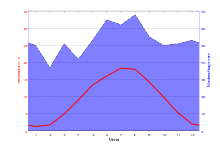
Climate diagram of Braunschweig, 1981 to 2010
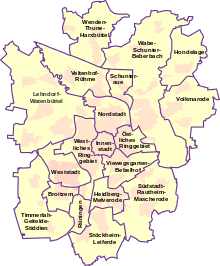
Structure of the city districts as of 2011
Economy and infrastructure
→ Main article: Economic history of the city of Braunschweig
The city and region of Braunschweig have experienced several structural changes in their history. Until after the Second World War, Braunschweig was a centre of the canning industry with many processing plants as well as a specialised mechanical engineering industry, including Schmalbach-Lubeca.
With the decline of the canning industry and the migration of the industry to other countries, the focus shifted towards the automotive industry, but also to the areas of transport technology, biotechnology, health care and finance. Also history is the photo industry with the traditional companies Voigtländer and Rollei. Representative studies certify that the city of Braunschweig is by far the most business-friendly in Germany.
In 2016, the gross domestic product of Braunschweig, within the city limits, was €11.733 billion, placing it 32nd in the ranking of German cities by economic output. The GDP per capita in the same year was €46,928 (Lower Saxony: €34,812/ Germany €38,180). There were approximately 163,800 employed people in the city in 2017. The unemployment rate was 4.9% in December 2018, slightly below the Lower Saxony average of 5.0%.
In the 2016 Future Atlas, the independent city of Braunschweig ranked 36th out of 402 districts and independent cities in Germany, making it one of the places with "very high future opportunities".
Industry and trade
Braunschweig was the headquarters of the Büssing automobile works, which was taken over by the MAN company until 1972. MAN vehicles still bear the Büssing company logo, a stylized Braunschweig lion, on the radiator grille, but are produced in Salzgitter, 20 kilometers south of Braunschweig.
The first Volkswagen plant, the so-called "Vorwerk", went into operation in Braunschweig in 1938. The automotive industry is still one of the most important industries in the city. Today, a VW plant and numerous medium-sized supplier companies are located in the city. In addition, the commercial vehicle holding company of the Volkswagen Group and Volkswagen Financial Services AG (including Volkswagen Bank) as well as Braunschweigische Landessparkasse and Öffentliche Versicherung Braunschweig have their corporate headquarters in the city. But private banks and direct banks, e.g. Bank von Essen, Bankhaus Löbbecke, Berenberg Bank, Volksbank Braunschweig Wolfsburg, Braunschweiger Privatbank and PSD Bank Braunschweig are also represented.
The city is home to a traditional Siemens AG plant, which also goes back to Heinrich Büssing and is a world leader in railway automation (see Siemens plant Braunschweig) and has developed, among other things, the railway operating technology for the Transrapid in Shanghai. The Siemens Mobility Group values Braunschweig in part because of the Technical University of Braunschweig and the branch of the German Aerospace Center (DLR), which, as a center of excellence for transportation technology, also conducts aerodynamic research for the rail industry. Another company from the mobility sector is Bombardier Transportation, which, like Bosch Engineering GmbH, has one of its sites in Braunschweig. More recently, DB ProjektBau GmbH has been based in Braunschweig. The focus of this railway subsidiary is on control and safety technology. In addition, numerous automotive suppliers have their headquarters in Braunschweig. Numerous high-tech companies have their headquarters in the vicinity of the airport, e.g. Aerodata AG, founded as Aerodata Flugmesstechnik GmbH, which is the world's largest supplier of flight measurement systems.
Voith Turbo Aufladungssysteme GmbH & Co KG maintains a development center in Braunschweig. The company Alstom plans to expand the existing maintenance center and develop it into a "national competence center for train maintenance and service" within the next few years. A large number of technical service providers, such as Brunel GmbH, and technical consultancies, such as the m+p Group, also operate from Braunschweig. In addition, Action Europe GmbH (formerly Devil AG), a large IT distributor and one of the companies with the highest turnover in Lower Saxony, is also based here.
With around 3900 employees (as of 2014) at its three sites, Braunschweig Municipal Hospital is one of the city's largest employers.
According to a study by the economic research institute Prognos, Braunschweig is one of the most successful cities in Germany in the field of information and communication technology. As a result, a large number of nationally and internationally renowned advertising agencies have settled in the city. Overall, the economic situation is developing above average. For example, the city experienced employment growth of 8.6% between 2005 and 2010; its income tax power grew by 31.1% over the same period. This can be attributed to the numerous new businesses that have been established. In a nationwide comparison, Braunschweig achieved first place here in a 2011 study by the Initiative Neue Soziale Marktwirtschaft. There were 146 young entrepreneurs for every 10,000 people of working age. An example of the success of young start-up companies is the Braunschweig e-commerce company Pizza.de. In 2012, Braunschweig was one of the ten most dynamic cities in Germany. In addition, Braunschweig, together with Stuttgart, is the region in the European Union where, in percentage terms, the most employees work in cutting-edge and high-tech sectors, namely 22 % each.
"Oker Valley"
→ Main article: Economic history of the city of Braunschweig#"Oker Valley"
Until its demise in the early 1990s, the computer company Commodore International, which was very successful in the 1980s, maintained a factory in Braunschweig. Among other things, the legendary C64 was manufactured here. Until 2014, Braunschweig was home to Intel's largest chip development center in Europe with around 120 employees. Since 2000, six chips have been developed here that are currently in use. In the European Competence Center for High-Performance Computing (HPC) technology, chips for supercomputers are also developed in Braunschweig. At the TU Braunschweig, Intel finances the main course of studies "Advanced VLSI-Design" (Very Large Scale Integrated Circuits), which deals intensively with the development of highly complex microchips in order to promote the training of highly qualified employees at the location. However, in the fall of 2013, the announcement was made to close this site. The site and its employees were subsequently taken over by Fujitsu. Today, Braunschweig is recognized as an IT stronghold in Germany. The proportion of IT professionals here is three times the national average and twice that of comparable major cities.
The "Cooperation Initiative in Mechanical Engineering" is an association of medium-sized mechanical engineering companies from the Braunschweig region that purchase together, increase employee qualifications and also cooperate in other areas. A similar cooperation agreement has also been made by companies from the IT sector under the name "Federated IT" to enable the joint implementation of projects. One well-known mechanical engineering company located in Braunschweig is Bühler.
Traditionally, Braunschweig has been a centre of the sugar industry since around 1850 due to the intensive cultivation of sugar beet in the Braunschweig region. Nordzucker AG, which was formed by a merger of several sugar factories, has chosen Braunschweig as its corporate headquarters. It is now the second largest German producer of sugar products. This complex of topics is also addressed in the field of research. The Technical University of Braunschweig has had its own research institute for sugar production and processing for decades.
Braunschweigische Maschinenbauanstalt (BMA AG) is one of the leading companies in the field of mechanical engineering for the industrial processing of renewable raw materials. With the law firm Appelhagen und Partner, the largest law firm in Lower Saxony and Saxony-Anhalt is located in Braunschweig.
Braunschweig is the headquarters of the internationally active textile company New Yorker and its subsidiary "Ann Christine". Other well-known companies and institutions are the coffee roaster Heimbs, founded in 1880, the men's textile company Dittmar (Signum shirts) and the Westermann printing and publishing group. The Richard Borek group of companies is also based in Braunschweig. "Borek" is one of the oldest mail order companies in Germany (since 1906). In 1996, the specialist kitchen retailer Küchen Aktuell was founded.
Braunschweiger Versorgungs AG & Co KG is one of the 50 largest companies in Lower Saxony.
With over 1300 retail shops, Braunschweig is a central shopping location for the region and has also been a Fair Trade city since 2014.
In addition, the city is one of the administrative headquarters of the Chamber of Crafts Braunschweig-Lüneburg-Stade, whose chamber district includes the independent cities of Braunschweig, Salzgitter and Wolfsburg as well as the districts of Helmstedt, Goslar, Peine and Wolfenbüttel.
Media
Braunschweig is home to a studio of the North German Broadcasting Corporation (NDR). Two private radio companies, Antenne Niedersachsen and Radio ffn, also have regional studios here.
Regional daily newspaper is the Braunschweiger Zeitung (BZ), which also prevails in the region under different titles with different local sections. In 2007, the Braunschweiger Zeitung was taken over by the WAZ Media Group (today: Funke Media Group). As free weekly newspapers, the Neue Braunschweiger and Neue Braunschweiger am Sonntag, published by BZ-Verlag, are distributed to households. Online newspapers for Braunschweig are the daily newspaper NEUESausBraunschweig, which has been published since April 2013, and regionalBraunschweig.de (as BraunschweigHeute) since 2014. Since May 2016, news38.de has been online, a free news portal that primarily offers information from the postcode region 38, but also national news.
City magazines: The family magazine Clicclac is published monthly with a circulation of 25,000 copies and 560 distribution points. The magazine Subway is published monthly with a circulation of 20,000 issues and 300 distribution points. The district magazines Druff, Nordlicht, Tangente and Westblick are published with smaller circulations in various districts of Braunschweig. The magazine Stadtglanz is published quarterly. Previously, the monthly magazines Da Capo (1989-6/2017) COCKTA!L (1990-2005), chexx (1999-2007) and Backstage (2005-2014) were also published, as well as the sports magazines 33 (1994-1995) and abseits with a focus on Braunschweig's football region.
There is also an independent publishing company that publishes advertising newspapers for Braunschweig and the Braunschweig area. Products are the Braunschweig Report, the Wochenblatt zum Sonntag and Ambiente. Another advertising newspaper is Extra am Sonntag for Braunschweig.
In Braunschweig and the surrounding area, the non-commercial, local community radio station "Radio Okerwelle" broadcasts on the frequency 104.6 FM and the commercial station Radio 38 broadcasts on the frequency 100.3 FM. In addition, "TV38", a non-commercial community TV, maintains a studio in the city (in addition to other studio locations in Wolfsburg and Salzgitter). Radio Okerwelle and TV38 are two of 15 Lower Saxony broadcasters of community radio. In addition, the Braunschweig-based Ideeal advertising agency operates an event radio station on the 90.5 frequency with a focus on Eintracht Braunschweig.
In Cremlingen, Deutsche Telekom AG operated a medium-wave transmitter on behalf of Deutschlandfunk (DLF) until the end of 2015. This transmitter was often referred to as "Sender Braunschweig", although it was not located in the urban area of Braunschweig (see Rundfunksendetelle Cremlingen-Abbenrode).
Musical instrument making
Braunschweig was and is one of the centres of the German musical instrument industry. Among others, Wilhelm Schimmel Pianofortefabrik GmbH, the largest German manufacturer of upright and grand pianos, and Grotrian-Steinweg GmbH, another well-known manufacturer, are based here. Stringed instruments have been made in Braunschweig since 1844 by the Rautmann family of violin makers (five generations). After a short closure due to the death of Elfi Rautmann, master luthier Matthias Vorbrodt from Wernigerode reopened the workshop in 2013. The company Sandberg Guitars manufactures high-quality electric guitars and electric basses.
Science
In the entire European Economic Area (EEA), the Braunschweig region has the highest density of scientists, a high rate of engineers in a nationwide comparison and the highest intensity in the area of expenditure on research and development. In the Braunschweig region, more than 16,000 people from over 80 countries work and research in 27 research institutes and 20,000 employees in 250 high-tech companies on the issues of the future. The concentration of employees in research and development in Braunschweig is about five times higher than the national average. In 2010, 5.83 % of the gross domestic product (GDP) was spent on research in Braunschweig. Furthermore, the expansion of research is continuously being driven forward. For example, in the years 2012 to 2014 alone, over 200 million euros were used to build new research infrastructure.
The city is home to three universities, a university of cooperative education and a large number of federal institutes and research facilities. The Carolo-Wilhelmina University of Technology was founded in 1745 as the "Collegium Carolinum", making it the oldest technical and scientific university in Germany. In 1862 it was transformed into the "Herzogliche Polytechnische Schule" and in 1877 it was elevated to the status of a "Technische Hochschule". Since the addition of a Faculty of Philosophy and a Faculty of Political Science in 1968, it has been a "Technical University". The Ostfalia - University of Applied Sciences was founded in 1971 by merging the State School of Engineering Wolfenbüttel with the Higher Technical School for Social Work of the State of Lower Saxony. Further faculties were added. The Hochschule für Bildende Künste Braunschweig (HBK) was founded in 1963 from the former Werkkunstschule Braunschweig. This architectural-technical drawing institute was opened in 1790 by order of Duke Karl Wilhelm Ferdinand. In 1972 it became a scientific university and since 1978 it has had the status of an artistic-scientific university. It is the only art college in Lower Saxony and among the five largest in Europe. There are more than 300 in Europe. At the state-recognised Welfenakademie it is possible to complete a dual course of study in business administration. At the German Milling School in Braunschweig, the world's only state-certified degree can be obtained as a process engineer for mill construction, grain and animal feed management.
The Federal Office of Civil Aeronautics and the Federal Bureau of Aircraft Accident Investigation are located in Braunschweig. On the basis of the Time Act, the Physikalisch-Technische Bundesanstalt (PTB) has had the task of setting the time in Germany with its atomic clocks since 1978. The impulse for the control of radio-controlled clocks comes from PTB, but the time is transmitted via the long-wave transmitter DCF77 southeast of Frankfurt am Main. In addition to time, PTB is responsible for various technical and scientific measurands such as length and mass.
A unique selling point is the concentration of companies, authorities and research institutions in the field of mobility, specifically aviation technology, aviation safety, space travel and transport. Braunschweig-Wolfsburg Airport is the location of the German Aerospace Center (DLR), which emerged in 1969 (initially as "DFVLR") from the German Aeronautics Research Institute (DFL) founded in 1936. The main areas of work are flight mechanics, flight guidance and air traffic control, aerodynamics and the development of powerful tools for calculations as well as structural systems (adaptronics and extreme lightweight construction). The site works closely with the neighbouring Federal Aviation Office, the Technical University, technology transfer offices and other resident research institutions. For example, researchers from the TU Braunschweig and DLR were involved in the development of the Philae lander and the Rosetta space probe, and thus in the first landing of a man-made object on a comet. A special feature of the site is the highly developed infrastructure with research aircraft, wind tunnels, simulators and test stands, which is concentrated in one place alongside the airport infrastructure. In total, more than 2800 employees work at the airport in basic research and application-oriented technology development and testing. The world's first automatic satellite-controlled aircraft landing took place at Braunschweig Airport as early as 1990.
In the Patent Atlas of the German Patent and Trade Mark Office, the Braunschweig region ranks first in Lower Saxony with 1200 patent applications for the year 2005 and seventh in the nationwide comparison. This applies in particular to patents in the technical fields of "vehicles, ships, aircraft" and "measuring, testing, optics, photography". One example of this is the Stadtpilot project. The world's first self-driving car ("Leonie") in heavy inner-city traffic was successfully tested on the Wilhelminischer Ring in 2011. The research and testing of modern traffic light and car systems based on the Intelligent Mobility (AIM) application platform and the award as a showcase for electromobility make Braunschweig the centre of German mobility research. This top position is underlined in an international context by the strong expansion of research at the NFF. In the future, more than 200 scientists will work there on mobility concepts of the future.
The Helmholtz Centre for Infection Research (HZI), formerly the Gesellschaft für Biotechnologische Forschung (GBF), is a centre for infection research. Its research focus is on pathogens that are medically relevant or used as models for the study of infection mechanisms. The HZI is funded by the Federal Republic of Germany (90 %) and the State of Lower Saxony (10 %).
Other federal institutions and research facilities in Braunschweig are or were:
- Federal Biological Research Centre for Agriculture and Forestry (BBA) (dissolved on 31 December 2007)
- Battery LabFactory Braunschweig (BLB)
- Braunschweig Integrated Centre for Systems Biology (BRICS)
- Brunswick Centre for Gender Studies
- Braunschweig Information Technology and Technology Center (BITZ)
- Brunswick Scientific Society (BWG)
- Federal Office of Consumer Protection and Food Safety (BVL)
- Federal Agricultural Research Centre (FAL) (dissolved on 31 December 2007)
- Center for Computer Science and Information Technology (tubs.CITY)
- German Accreditation Body (DAkkS), Metrology Division with headquarters in Berlin
- German Collection of Microorganisms and Cell Cultures (DSMZ) in the Leibniz Association
- German Centre for Infection Research (DZIF)
- Drug Research and Functional Genomics Centre (DRFG)
- Epitaxy Competence Center (ec²)
- Research Institute of Feed Technology (IFF)
- Fraunhofer Institute for Wood Research (WKI), also known as the "Wilhelm Klauditz Institute
- Fraunhofer Institute for Surface Engineering and Thin Films (IST)
- Fraunhofer Institute for Toxicology and Experimental Medicine, headquartered in Hannover, Germany
- Fraunhofer Project Center for Energy Storage (CES) (in planning; joint platform of TU and Fraunhofer institutes)
- Friedrich-Loeffler-Institut (FLI), Federal Research Institute for Animal Health with headquarters on the island of Riems (Greifswald) (emerged from the dissolved FAL)
- Georg Eckert Institute for International Textbook Research (GEI)
- Society for Plant and Reactor Safety (GRS)
- Intelligent Transport Systems Lower Saxony (ITS Lower Saxony)
- Institut Nehrig (food, consumer goods and environmental analysis)
- Institute for Applied Radio Systems (IAF)
- Johann Heinrich von Thünen Institute (vTI), Federal Research Institute for Rural Areas, Forests and Fisheries (emerged from the dissolved FAL)
- Joint Optical Metrology Center (JOMC)
- Competence Center Wind Energy (under construction)
- Julius Kühn-Institut (JKI), Federal Research Institute for Cultivated Plants with headquarters in Quedlinburg (emerged from the dissolved FAL and the BBA)
- Laboratory of Emerging Nanometrology (LENA)
- Food and Veterinary Institute of the Lower Saxony State Office for Consumer Protection and Food Safety (LAVES)
- Materials Testing Institute for Building (MPA), Institute for Building Materials, Solid Construction and Fire Protection (IBMB)
- Nanotechnology Competence Center Ultraprecise Surface Processing e. V. (CC UPOB e. V.)
- Lower Saxony Research Center for Automotive Engineering (NFF)
- Lower Saxony Research Centre for Aviation (NFL)
- Centre for Agricultural Meteorological Research (ZAMF) of the German Weather Service
- Center for Fire Research (ZeBra)
- Centre for Light and Environmentally Friendly Construction (Zeluba)
- Center for Microproduction (ZeMPro)
The Donors' Association for the Promotion of Sciences and Humanities in Germany awarded the city the title "City of Science 2007". The award also acknowledged the commitment of various players to networking science, especially with business and culture, and to opening up science to the city's citizens. Braunschweig's application under the motto "Braunschweig Kitchen of Ideas" with its experimental concept was certified by the jury as "original and comprehensible".
With the "Braunschweig Kitchen of Ideas" in 2007, the idea was born to create a place that would continue to promote dialogue with science in the future. The Haus der Wissenschaft Braunschweig GmbH was founded in the former Pädagogische Hochschule in Pockelsstraße. The house focuses on interactive events and at the same time promotes the exchange between universities and research institutions with business, culture and educational institutions.
Other educational institutions include:
- State Education Centre for the Hearing Impaired
- Volkswagen Financial Services Academy
- Clinic for Urology and Uro-oncology for residency training
Traffic
→ Main article: Traffic in Braunschweig and Port of Braunschweig
Braunschweig has been located at the crossroads of several long-distance trade routes since the Middle Ages. The Oker River, which flows through and around the city, was navigable until modern times.
Today, several federal motorways (e.g. the A 2 and the A 39) and federal highways lead to Braunschweig or directly through the city (e.g. the B 1, the B 214 and the B 248). Braunschweig has a port with a connection to the Mittelland Canal, which connects inland shipping with Berlin, Hamburg and the Ruhr area, and since 1935 has its own airport in Waggum, the Braunschweig-Wolfsburg Airport.
Braunschweig's main station was opened in 1960 and replaced the inner-city Braunschweig station, a terminus built in 1845, whose listed main building now serves as the headquarters of the Braunschweigische Landessparkasse. As early as 1838, the first German state railway from Braunschweig to Wolfenbüttel began operations here. Today it is a system stop for the IC and ICE network as well as for regional local traffic. In addition, Deutsche Bahn operates a station in Braunschweig-Gliesmarode.
The Regional Association of Greater Braunschweig is planning three new railway stations in Bienrode, Leiferde and Braunschweig-West, which are to be opened by 2026.
The city's local public transport (ÖPNV) is provided, among other things, by a tram and city bus system operated by Braunschweiger Verkehrs-GmbH within the Verkehrsverbund Region Braunschweig (VRB). The surrounding area is served by several regional transport companies, mainly with regional bus lines. In addition, a regional rail transport system was planned from Goslar via Braunschweig to Uelzen, the RegioStadtBahn Braunschweig, which also runs within the city. The planning of this light rail system was stopped in 2010 due to lack of funding and replaced by the regional rail concept 2014+.
For the first time worldwide, battery-powered buses in local public transport are operated with induction technology.
As early as April 1904, Heinrich Büssing had opened the motor bus line of the "Automobil-Omnibus-Betriebs-Gesellschaft Braunschweig" (AOBG) on the Wendeburg-Braunschweig route. It served as a practical test for the buses he had built in his factory. It is also the first and oldest bus line in the world that is still in operation today. At that time, up to twelve passengers were transported per trip at a maximum speed of 30 km/h.
The "Braunschweig Airship Association" was founded as early as 1909. On 13 October 1912, the airship "Hansa" landed in the city. Subsequently, Braunschweig was called the "city of aviators". Before the First World War, there were two airfields in Braunschweig: in Waggum and Völkenrode. A third, at Broitzem, followed in 1916. Braunschweig-Waggum was an important airfield in Germany.
Cycling plays a significant role in Braunschweig and had a share of around 21% on weekdays and just under 24% on Sundays in 2012. There is a dense network of cycle paths in the city. Cycle tourism is more important for weekend trips in Braunschweig and the surrounding area, long-distance cycle tourism is only slightly developed: Braunschweig is not connected to the primary German long-distance cycle route network of the D-routes.
Tourism and congress city
At present, efforts are being made to strengthen Braunschweig as a trade fair and congress location. Among other things, extensive modernisation work has been carried out on the Stadthalle. This is accompanied by the complete reorganisation and upgrading of the station quarter through the construction of the BraWoPark, combined with the construction of an InterCityHotel and a specialist retail centre. The new youth hostel on the corner of Wendenstrasse and Neuer Geiershagen was opened on 23 April 2015.
The European Long Distance Trail E6 leads - coming from Essehof - through the Dibbesdorfer Holz, along the wooded area Im Lah, through the district of Schapen, through the nature reserve Riddagshausen and the Buchhorst, along the Rautheimer Holz - at the southern edge of which there are remains of the Braunschweiger Landwehr on the right of the trail - as well as along the Niederdahlumer Holz and then along the Oberdahlumer Forst, which belongs to Wolfenbüttel, into the Lechlumer Holz, which also belongs to Wolfenbüttel.
.JPG)
New Youth Hostel Braunschweig, 2015
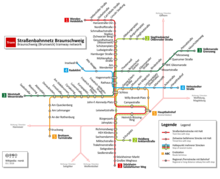
Route network of the Braunschweig tramway
.jpg)
Latest generation tramcar, in operation since April 2015

Brunswick main station
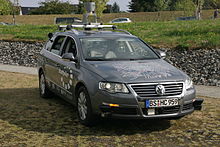
Leonie, the autonomous vehicle of the Stadtpilot project
.jpg)
Atomic clock "CS 4" of the Physikalisch-Technische Bundesanstalt
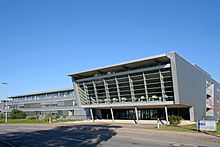
German Federal Aviation Authority

TU Braunschweig, old building
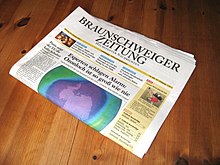
The Braunschweiger Zeitung
.JPG)
Copy of the "Golden Edition" of the Commodore 64 from December 1986
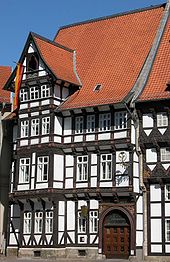
Chamber of Crafts Braunschweig-Lüneburg-Stade in the Veltheim House
Search within the encyclopedia
.svg.png)